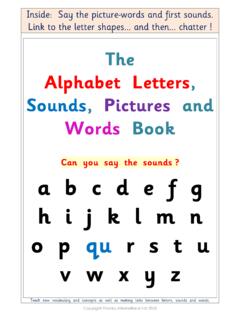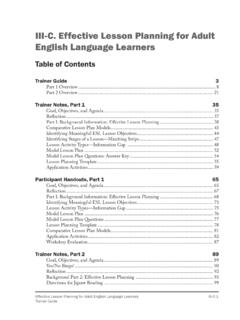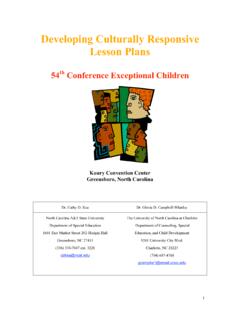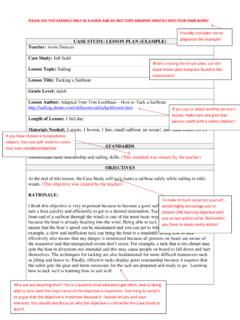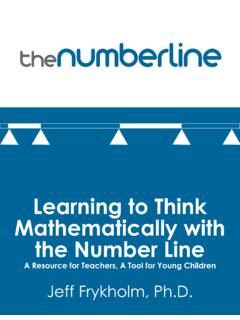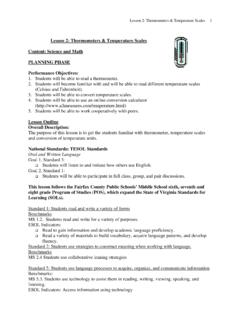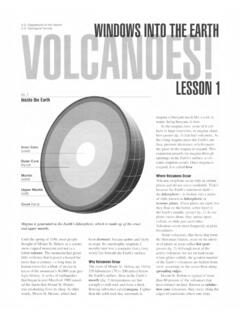Transcription of Basic Phonics Lesson Format
1 Choices for Basic Phonics Lessons .. Basic Phonics Lesson Format : The standard Lesson Format for introducing letter/s-sound correspondences has a very simple structure: 1. Revise old learning of the letter/s-sound correspondences of The Alphabetic Code taught to date. 2. Introduce new learning of next letter/s-sound correspondence. 3. Include the new letter/s-sound correspondence to practise the three skills of blending, segmenting and handwriting at word level using the cumulative word bank (sometimes with an emphasis on a particular skill as decided by the teacher).
2 Note that the Sounds Book Activity Sheets build up a cumulative word bank as letter/s-sound correspondences are taught or revisited. 4. Extend to sentence level and text level work with cumulative word bank as appropriate (this will become part of the Basic Lesson Format over time). See variety of resources in each unit for extension work. Note: With good understanding of the synthetic Phonics teaching principles, teachers and parents do not need elaborate resources or programmes.
3 Phonics International provides free start-up resources and good information in unit 1 for teachers and parents so that they can teach reading and spelling with this approach. The Phonics International programme is then available to people who would like support with the breadth and depth of systematic detailed resources for the teaching and learning processes. Description of Basic Lesson Possible resources for visual display, and for supporting and developing the teaching and learning activities 1.
4 Revise old learning : Young learners sit in area in front of teacher s board. Older learners sit at desks facing the teacher s board. Aim for revisiting old learning to be fast-paced, focused and lively. For general reference, select a version of The Alphabetic Code Overview Chart as preferred and display on wall (available in unit 1). Simpler versions available in Early Years Starter Package showing only graphemes featured in units 1 to 5 or units 1 to 6. Graphemes previously taught can be seen in rows across the top of the teacher s board.
5 Teacher points to graphemes from left to right and then in random order. Learners say the sounds (reading sub-skill). Then, the teacher says the sounds , learners point to the corresponding graphemes (spelling sub-skill). Grapheme Tiles laminated with sticky magnetic tape, or magnetic letters, or previously taught graphemes written across top of teacher s board. Alternately, use Say the Sounds Posters for appropriate unit of work. OR: Teacher flashes grapheme flash cards of previously taught graphemes (letters and letter groups).
6 Learners call out the sounds collectively. Teacher may ask individuals to say the sounds . Selection of Simple Code Flash Cards available in unit 1 Extensive set of Picture Flash Cards in Early Years Starter Package for units 1 to 6 Complex Code Flash Cards available in unit 6. 2. Introduce new learning : Today we are going to learn about this letter [or these letters together, or this grapheme] which is code for the sound /../ as in the word .. Let s say the new sound together and listen for where we can hear it in the following words.
7 Teacher can use ANY words with focus sound for ORAL work. Use words from cumulative word bank if words are to be seen as PRINT. Teacher maps sound to graphemes as appropriate for new learning by finger-tracking under graphemes as sounds are uttered. [For young beginners using the Early Years Starter Package, at this point they could go to their tables and glue paper versions of Grapheme Tiles in their Sounds Books. Eventually they can glue in Word Lists too.] Next Grapheme Tile or magnetic letter/s (or simply write down the focus grapheme on teacher s board).
8 OR: Produce next Flash Card from preferred Flash Cards. Visual display: Focus grapheme Alphabetic Code Frieze Poster, Mini Poster and, when appropriate, the Grouping the Spelling Alternatives Poster (this has a pupil activity equivalent without pictures). Posters are useful when laminated - use bulldog clips or blu-tak to fix onto board edges for Lesson introduction. In units 1 to 6, the Picture Posters and/or audio-visual online resource Hear the Sounds can be used to support new learning . Colour-in Sounds Book - learners activity Say the Sounds Booklet - for home- learning Copyright 2009 Debbie Hepplewhite and Practise three skills of blending, segmenting and writing as appropriate: BLENDING - If teacher uses magnetic Grapheme Tiles or magnetic letters on a magnetic whiteboard, teacher can select Grapheme Tiles and make new words for learners to blend which include the new letter/s-sound correspondence.
9 Learners sound out and blend all-through-the-word to hear the target words. OR: Teacher can simply write words to blend on the board. Refer to cumulative word bank for support if necessary on Sounds Book Activity Sheets (Word Bank also provided in Early Years Starter Package). Blend Word Cards can be used as flash cards (hold samples for blending in the air) or laminated with magnetic sticky tape or blu-tak to display on board. Enlarge Sounds Book Activity Sheet to A3 to use with whole class or group if preferred.
10 This is useful particularly with new beginners to model how they can use the activity sheets independently. SEGMENTING - Use a multi-sensory routine particularly for younger learners and beginners. Teacher models, learners join in: - hold up left fist, palm facing. Teacher says word to be spelt very slowly so the individual sounds pop out . At first, teacher supports new learners to hear and identify the sounds all-through-the-spoken-word. The number of sounds are tallied on left thumb then fingers from left to right of left hand.



